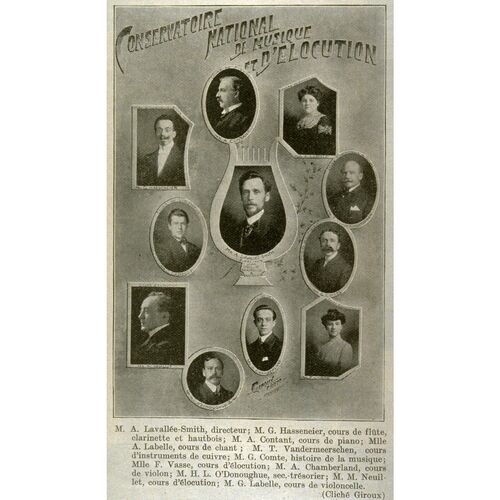LAVALLÉE-SMITH, ALPHONSE (baptized Louis-Alphonse-Émile Smith), organist, composer, music dealer, teacher, and administrator; b. 17 April 1873 in Berthier (Berthierville), Que., son of Wenceslas Smith, a physician, and Zénobie Lavallée, a first cousin of Calixa Lavallée*; m. 15 Oct. 1903 Julie-Anna Désaulniers, daughter of Dr Denis-Benjamin-Guillaume Desaulniers, in the parish of Saint-Jean-Baptiste at Nicolet, Que., and they had a son and two daughters; d. 23 July 1912 of tuberculosis in Sainte-Agathe-des-Monts, Que., and was buried 26 July in Nicolet.
When he was six Alphonse Lavallée-Smith began studying music with his mother, who was a pianist and organist, and a maternal aunt who was organist of the church in Berthier. At seven he was able to play the piano accompaniment for singers at a charity concert. A short time later the family moved to Saint-Thomas-de-Pierreville (Pierreville), where Dr Smith would practise medicine for the next 12 years. As organist of the parish church, Mme Smith often called upon Alphonse to replace her; the young man performed this task well, even improvising some occasional pieces, among them a short funeral march, his earliest composition. He did his classical studies at the Séminaire de Nicolet from 1885 to 1893, at the same time pursuing his musical training with Octave Hardy, dit Chatillon. Besides taking part in school activities, especially concerts and lyric productions, he served as organist at the Nicolet cathedral for three years.
Upon completion of his studies Lavallée-Smith set up in business as a music dealer in Montreal. While perfecting his artistry with Romain-Octave Pelletier*, the organist at the Roman Catholic cathedral there, he also assisted Dr Salluste Duval, the organist at the church of Saint-Jacques, and for a time replaced the organist of Notre-Dame church. Then, having decided to devote himself entirely to music, he gave up the business world and left for Paris late in 1896. He studied the organ and composition with such teachers as Eugène Gigout, Théodore Dubois, Alexandre Guilmant, and Charles-Marie Widor. On his return to Montreal towards the end of 1897 he became the organist at the church of Saint-Henri, a post he would hold for 15 years. He also taught piano and harmony at the Petit Séminaire de Montréal and gave private lessons in piano, organ, solfège, harmony, and counterpoint.
Apart from a few pieces for organ and piano, almost all of Lavallée-Smith’s work consists of solo and choral church music: motets, antiphons, and canticles based on Latin and French texts. Among his more important compositions is the Messe des morts for three voices, which was sung for the first time at his funeral. In his sacred music Lavallée-Smith adopted a traditional style, following in the traces of his French teachers, whom he revered. Most of his works remain unpublished, and liturgical development since 1900 does not favour even a minor revival.
Lavallée-Smith put his signature to a few songs for voice and piano and some patriotic songs. His “Cantate du séminaire de Nicolet,” with words by Louis Fréchette*, was composed in 1903 to mark the centenary of the institution. As well, he wrote a one-act operetta entitled Gisèle, with libretto by Dr Honoré Thibault, but only the version for piano and voice was finished by 1910. An arrangement for orchestra by Alfred (Al) Stoupanse was used when the work was first performed, posthumously, on 23 Oct. 1924 at the Monument National, with soprano Caroline (Caro) Lamoureux in the title role. This operetta was called “brilliant” by La Presse, which even spoke of a “triumphal success,” and it was revived the following year on 19 May, this time with Thérèse Lefebvre. Baritone Lionel Daunais* took part in both performances.
Alphonse Lavallée-Smith’s major accomplishment will probably remain the Conservatoire National de Musique et d’Élocution, an institution he founded in the autumn of 1905 and to which he devoted the last years of his short life. The conservatory, which was affiliated from 1921 to 1951 with the Université de Montréal, can be considered the forerunner of the university’s current faculty of music.
Some 130 manuscript and published scores by Alphonse Lavallée-Smith were brought together by Jean Chatillon and deposited in the Bibliothèque Nationale du Québec (Montréal), mss–267.
AC, Trois-Rivières, État civil, Catholiques, Saint-Jean-Baptiste (Nicolet), 15 oct. 1903, 26 juill. 1912. ANQ-M, CE5-1, 19 avril 1873. L’Album universel (Montréal), 20 févr. 1906: 1300. La Presse, 17 juill. 1920 (includes a photo of Lavallée-Smith); 18, 24 oct. 1924. Dictionnaire biographique des musiciens canadiens (2e éd., Lachine, Qué., 1935), 168 (also includes a photo). Encyclopedia of music in Canada (Kallmann et al.). M.-T. Lefebvre, “Histoire du Conservatoire national de musique: 1922–1950,” Assoc. pour l’Avancement de la Recherche en Musique du Québec, Cahiers (Montréal), 3 (1984): 37–51.
Cite This Article
Gilles Potvin, “LAVALLÉE-SMITH, ALPHONSE (baptized Louis-Alphonse-Émile Smith),” in Dictionary of Canadian Biography, vol. 14, University of Toronto/Université Laval, 2003–, accessed November 9, 2024, https://www.biographi.ca/en/bio/lavallee_smith_alphonse_14E.html.
The citation above shows the format for footnotes and endnotes according to the Chicago manual of style (16th edition). Information to be used in other citation formats:
| Permalink: | https://www.biographi.ca/en/bio/lavallee_smith_alphonse_14E.html |
| Author of Article: | Gilles Potvin |
| Title of Article: | LAVALLÉE-SMITH, ALPHONSE (baptized Louis-Alphonse-Émile Smith) |
| Publication Name: | Dictionary of Canadian Biography, vol. 14 |
| Publisher: | University of Toronto/Université Laval |
| Year of publication: | 1998 |
| Year of revision: | 1998 |
| Access Date: | November 9, 2024 |


![Conservatoire de musique et d'élocution M. A. Lavallée-Smith directeur... [image fixe] : Original title: Conservatoire de musique et d'élocution M. A. Lavallée-Smith directeur... [image fixe] :](/bioimages/w600.6824.jpg)

